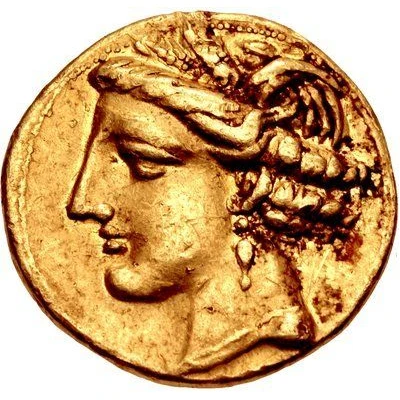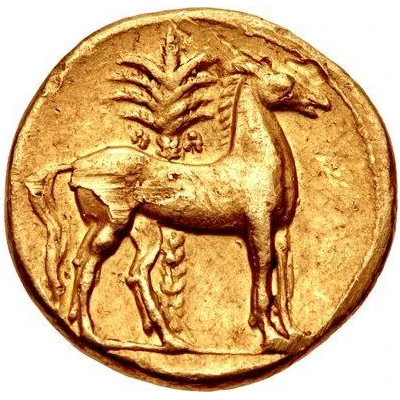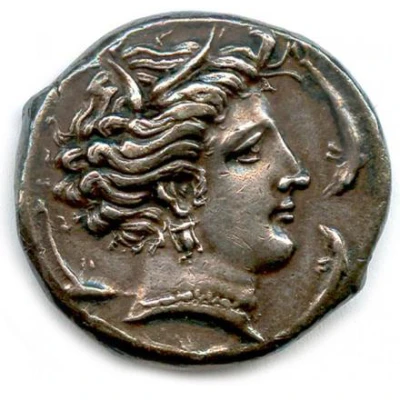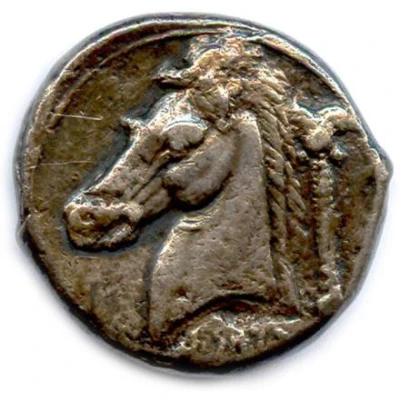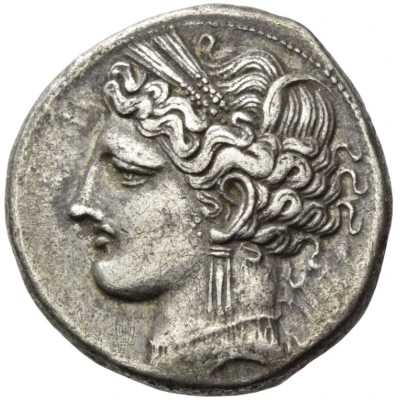
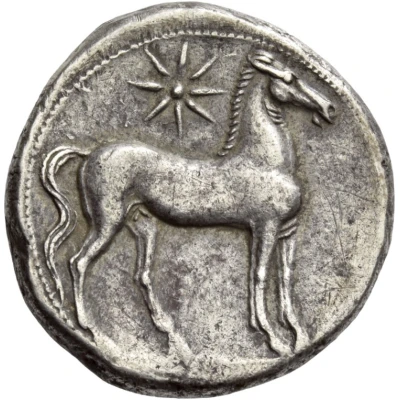

Doubleshekel 264 BC - 241 BC
| Silver | 13.45 g | - |
| Issuer | Carthage (Zeugitana) |
|---|---|
| Period | First Punic War (264 BC - 241 BC) |
| Type | Standard circulation coin |
| Years | 264 BC - 241 BC |
| Value | 2 Shekels |
| Currency | Shekel |
| Composition | Silver |
| Weight | 13.45 g |
| Shape | Round (irregular) |
| Technique | Hammered |
| Orientation | Variable alignment ↺ |
| Demonetized | Yes |
| Updated | 2024-10-09 |
| Numista | N#195689 |
|---|---|
| Rarity index | 100% |
Reverse
Horse standing right; above, eight-rayed star.
Comment
This coin was struck by the Punic (Phoenician) city of Carthage during its first great struggle against Rome for dominance in the western Mediterranean. The First Punic War (264-241 B.C.), was extremely costly for Carthage, and was finally lost when the Punic fleet was destroyed by the Romans at the Battle of the Aegates Islands (241 B.C.) and Carthage lacked the financial resources to rebuild it. Based on a Semitic rather than a Greek weight standard, coins like this trishekel were produced primarily to pay the North African mercenaries that served in the armies of Carthage. The obverse type is traditionally described as the head of Tanit, a North African goddess adopted by the Carthaginians as a local form of the Phoenician deity, Astarte. She became the chief goddess of the Carthaginian pantheon as the consort of Ba'al-Hammon, the supreme male deity of Carthage. She was a goddess of fertility as well as of war, which made her an appropriate figure to appear on money struck for military purposes. The benefaction of Tanit was sometimes invoked through the terrible rite of child sacrifice. Infants were placed alive into the sloping hands of her cult statue, only to roll down into a fire pit below. This ultimate sacrifice was thought to bring great blessings upon worshippers of the goddess, but was generally condemned by Greeks, Romans, and Persians. Ironically, the depiction of the very un-Greek Tanit is strongly influenced by the representations of Persephone popular on the silver coinage of Greek Syracuse in the fourth century B.C. Over the course of the long struggle between Carthage and Syracuse for control of Sicily, the Carthaginians were exposed to Syracusan coinage and took it as a model for their own. The horse on the reverse may refer to the foundation myth of Carthage ("New City" in Phoenician). It is reported that when the Tyrian queen, Dido, set out to establish her new city, diggers initially uncovered the head of an ox. This was interpreted as a sign that a city built on that site would be wealthy but subject to others. Unsatisfied, she had her builders consider a different site. When work began on the new site, the excavators dug up the head of a horse. This omen was read as a sign that a city there would become great in war. It was therefore decided to found Carthage on the second site. Thus, the horse on Carthaginian coins can be understood to have a double usage, both as an emblem of the city and as an appropriate symbol for a military coinage. (source: Numismatica Ars Classica, Auction 110 Catalog)
Interesting fact
The Doubleshekel coin was used as a form of currency in the ancient city of Carthage, which was located in present-day Tunisia. The coin was made of silver and weighed 13.45 grams, which was a significant amount for a coin at that time. Despite its weight, the coin was still widely used in trade and commerce, and it remains a valuable artifact for collectors and historians today.
